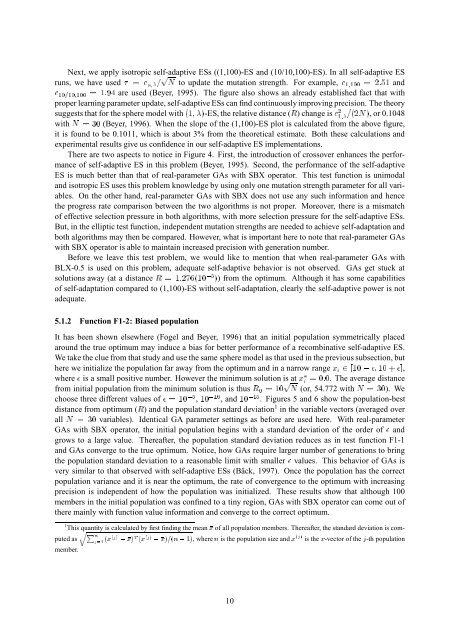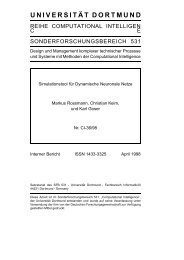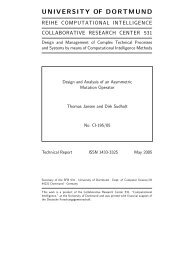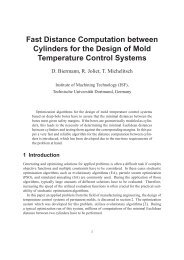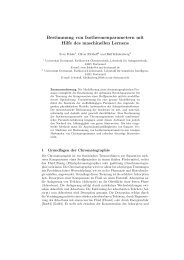Self-Adaptive Genetic Algorithms with Simulated Binary Crossover
Self-Adaptive Genetic Algorithms with Simulated Binary Crossover
Self-Adaptive Genetic Algorithms with Simulated Binary Crossover
Create successful ePaper yourself
Turn your PDF publications into a flip-book with our unique Google optimized e-Paper software.
Next, we apply isotropic self-adaptive ESs ((1,100)-ES and (10/10,100)-ES). In all self-adaptive ES<br />
runs, we have used=c;=pNto update the mutation strength. For example,c1;100=2:51and c10=10;100=1:94are used (Beyer, 1995). The figure also shows an already established fact that <strong>with</strong><br />
proper learning parameter update, self-adaptive ESs can find continuously improving precision. The theory<br />
suggests that for the sphere model <strong>with</strong>(1;)-ES, the relative distance (R) change isc21;=(2N), or 0.1048<br />
<strong>with</strong>N=30(Beyer, 1996). When the slope of the (1,100)-ES plot is calculated from the above figure,<br />
it is found to be 0.1011, which is about 3% from the theoretical estimate. Both these calculations and<br />
experimental results give us confidence in our self-adaptive ES implementations.<br />
There are two aspects to notice in Figure 4. First, the introduction of crossover enhances the performance<br />
of self-adaptive ES in this problem (Beyer, 1995). Second, the performance of the self-adaptive<br />
ES is much better than that of real-parameter GAs <strong>with</strong> SBX operator. This test function is unimodal<br />
and isotropic ES uses this problem knowledge by using only one mutation strength parameter for all variables.<br />
On the other hand, real-parameter GAs <strong>with</strong> SBX does not use any such information and hence<br />
the progress rate comparison between the two algorithms is not proper. Moreover, there is a mismatch<br />
of effective selection pressure in both algorithms, <strong>with</strong> more selection pressure for the self-adaptive ESs.<br />
But, in the elliptic test function, independent mutation strengths are needed to achieve self-adaptation and<br />
both algorithms may then be compared. However, what is important here to note that real-parameter GAs<br />
<strong>with</strong> SBX operator is able to maintain increased precision <strong>with</strong> generation number.<br />
Before we leave this test problem, we would like to mention that when real-parameter GAs <strong>with</strong><br />
BLX-0.5 is used on this problem, adequate self-adaptive behavior is not observed. GAs get stuck at<br />
solutions away (at a distanceR=1:276(10?5)) from the optimum. Although it has some capabilities<br />
of self-adaptation compared to (1,100)-ES <strong>with</strong>out self-adaptation, clearly the self-adaptive power is not<br />
adequate.<br />
5.1.2 Function F1-2: Biased population<br />
It has been shown elsewhere (Fogel and Beyer, 1996) that an initial population symmetrically placed<br />
around the true optimum may induce a bias for better performance of a recombinative self-adaptive ES.<br />
We take the clue from that study and use the same sphere model as that used in the previous subsection, but<br />
here we initialize the population far away from the optimum and in a narrow rangexi2[10?;10+],<br />
where is a small positive number. However the minimum solution is atxi=0:0. The average distance<br />
from initial population from the minimum solution is thusR0=10pN(or, 54.772 <strong>with</strong>N=30). We<br />
choose three different values of=10?5,10?10, and10?15. Figures 5 and 6 show the population-best<br />
distance from optimum (R) and the population standard deviation1 in the variable vectors (averaged over<br />
allN=30variables). Identical GA parameter settings as before are used here. With real-parameter<br />
GAs <strong>with</strong> SBX operator, the initial population begins <strong>with</strong> a standard deviation of the order of and<br />
grows to a large value. Thereafter, the population standard deviation reduces as in test function F1-1<br />
and GAs converge to the true optimum. Notice, how GAs require larger number of generations to bring<br />
the population standard deviation to a reasonable limit <strong>with</strong> smaller values. This behavior of GAs is<br />
very similar to that observed <strong>with</strong> self-adaptive ESs (Bäck, 1997). Once the population has the correct<br />
population variance and it is near the optimum, the rate of convergence to the optimum <strong>with</strong> increasing<br />
precision is independent of how the population was initialized. These results show that although 100<br />
members in the initial population was confined to a tiny region, GAs <strong>with</strong> SBX operator can come out of<br />
there mainly <strong>with</strong> function value information and converge to the correct optimum.<br />
1<br />
This quantity is calculated by first finding the meanxof all population members. Thereafter, the standard deviation is computed<br />
asqPnj=1(x(j)?x)T(x(j)?x)=(n?1), wherenis the population size andx(j)is thex-vector of thej-th population<br />
member.<br />
10


